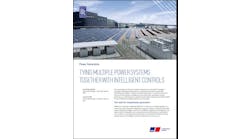EE Global in Washington, D.C. showcased some big energy efficiency innovations last week. Here’s a rundown…
Brainy light bulbs. Refrigerators that heat dishwasher water. Elevators that use no more energy than toasters. These are just a few of the “Oh Wow’ topics last week at the annual EE Global conference.
But it was growth in cities – and their buildings – that was clearly on the minds of industry leaders, 500 in total who gathered at the Washington, D.C. event, sponsored by the Alliance to Save Energy.
The US spends $432 billion per year on energy for buildings – more than what companies pay in taxes across America, more than what the private sector spends on research & development, and on par with the cost of health insurance for the private sector, said John Mandyck, chief sustainability officer of United Technologies Corporation.
Mandyck presented energy efficiency projects not as a cost, but as an investment with a favorable rate of return. Reducing energy use in buildings by 30 percent with readily available technology over 10 years would pay for the capital expense and generate a 30 percent internal rate of return, he said.
“It turns out energy efficiency is an outstanding investment choice for buildings,” Mandyck said.
Up with elevators
City populations are expanding, so more high rises are being built. More high rises mean more elevators, a big growth area for energy efficiency. Elevators waste a lot of energy. In fact, elevators in the US use five times the energy of Washington, D.C., according to early findings from a report expected out next month from the American Council for an Energy-Efficient Economy in collaboration with UTC, he said.
But new technologies exist that harness energy from gravity to make elevators significantly more efficient – getting their energy use down to less than that of a toaster, Mandyck said.
Andreas Schierenbeck, CEO of ThyssenKrupp Elevator, also gave an elevator speech. He described the 21st century as the “first century of the city.” Rapid population growth means cities must double their existing floor space within 11 years. Elevators use 10 percent of energy in high rise buildings, about 36,000 GWh per year, or 1.5 times the energy used by Las Vegas, he said.
When a light bulb goes off…
All of these buildings need lights too. Lighting accounts for 19 percent of world electrical energy production, according to Jeff Cassis, Philips’ senior vice president and general manager of global systems. The next stage of the lighting revolution offers a light bulb that “actually has intelligence and has the ability to talk and connect with the outside world.” This light bulb will be Internet connected and meld into the spaces where we work and play. It will “sense, anticipate, and seamlessly respond to a variety of different, changing needs and adapt to behaviors,” he said.
Incorporating energy efficiency is becoming a competitive play in cities, according to Andy Bennett, Schneider Electric’s senior vice president of infrastructure & energy. Cities must become as energy efficient as possible “not just because it is the right thing to do, but because every cent they save can be put back into the core infrastructure…education or parks or whatever it is they want to do to attract companies and people.”
Recycling kitchen waste heat
And let’s not forget the smart home, which is no longer so much about efficient gadgets, as efficient systems designed to serve a growing middle class. By 2030 the world’s middle class is expected to expand from two billion people to five billion, said Dave Szczupak, Whirlpool’s executive vice president of global product organization. This will contribute to as much as a 60 percent rise in energy use. That means appliances better become more efficient. One breakthrough technology from Whirlpool takes the waste heat made by a refrigerator and uses it to warm the water in the dishwasher.
The Alliance to Save Energy has set a goal to double energy productivity by 2030. This equates to making “every bit of energy we use last twice as long,” said Alex Laskey, Opower’s president. Is it doable? The chances are good because, as Laskey pointed out, energy efficiency enjoys a favorable position in society. No one wants to waste money on energy, “no matter who you vote for, or what bumper stickers you have on the back of your car.”
We tweeted from EE Global last week. Didn’t catch it? Keep up by following us on Twitter today @EfficiencyMkts.





